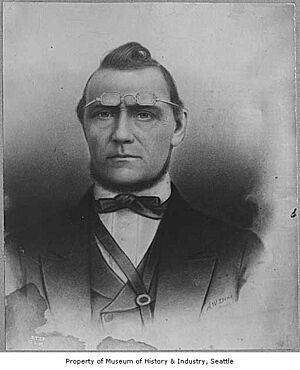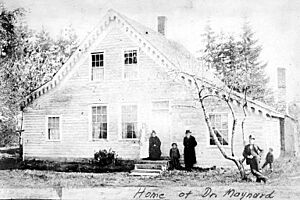Doc Maynard facts for kids
Quick facts for kids
Doc Maynard
|
|
|---|---|

Doc Maynard, circa 1868
|
|
| Born |
David Swinson Maynard
March 22, 1808 Castleton, Vermont, United States
|
| Died | March 13, 1873 (aged 64) Seattle, Washington Territory, United States
|
| Occupation | Pioneer, doctor, businessman |
| Spouse(s) |
|
| Children | 2 |
David Swinson "Doc" Maynard (born March 22, 1808 – died March 13, 1873) was an American doctor and businessman. He was one of the most important people who helped found the city of Seattle. Doc Maynard was Seattle's first doctor and one of its first merchants. He also served as a lawyer, a special agent for Native American affairs, and a Justice of the Peace. He played a key role in creating the Point Elliott Treaty in 1855.
Contents
Doc Maynard's Early Life
Doc Maynard was born into a well-off family near Castleton, Vermont. When he was 17, he was accepted into Castleton Medical School. He was a top student and trained with Dr. Theodore Woodward.
In 1828, he married Lydia A. Rickey. They had a daughter, Frances, and a son, Henry. In 1832, the Maynards moved to Cleveland, Ohio. At that time, Cleveland was a small town with only about 500 people. Doc Maynard tried different businesses, sometimes succeeding and sometimes losing money. He was involved in railroads and a medical school that failed during a big economic crisis called the Panic of 1837.
In 1850, Maynard left Cleveland and headed for California. On his journey, he helped many wagon trains fight cholera, a serious illness. When the leader of a wagon train going to Oregon Territory died, Maynard took charge. This led him to Puget Sound. On this journey, he met and fell in love with a widow named Catherine Troutman Broshears.
Starting a New Life in Seattle
Maynard joined the logging business at a place called New York-Alki, which later became Seattle. Instead of selling his wood for a low price, he made a smart business move. He leased a ship and sold his wood in San Francisco for much more money. With his earnings, he bought supplies to open a general store.
His store competed with the only other store in the area, which was in Olympia. This store was owned by Catherine's brother, Mike Simmons. Soon, Mike agreed to let Catherine marry Maynard.
Claiming Land in Seattle
In April 1852, Maynard claimed a large piece of land, about 640 acres, in what is now Seattle's Pioneer Square area. He hired Native Americans to help him build a cabin that also served as his store. This building quickly became a busy place, especially after Maynard became King County's first Justice of the Peace.
Maynard wanted to lay out the streets in his part of Seattle in a straight north-south direction. However, other founders like Carson Boren and Arthur Denny wanted the streets to follow the shoreline. This is why Seattle's downtown has some streets that bend and jog awkwardly where these different plans meet. The rest of King County, however, follows Maynard's original street design.
Working with Native American Tribes
Doc Maynard was very skilled at dealing with different Native American tribes. He helped calm tensions, especially between the Duwamish and the powerful Snohomish tribe, led by Chief Patkanim. As part of his efforts, Maynard worked to rename the settlement after the Duwamish leader, Chief Sealth (also known as "Seattle"). He even arranged an annual payment to Chief Sealth for this honor. This friendly relationship was very important during the Battle of Seattle (1856). Both Chief Sealth and Chief Patkanim kept their fighters out of the battle, which helped protect the settlers.
Maynard was one of 44 people who attended the Monticello Convention in 1852. His political skills were very useful in writing a request to Congress. This request asked the government to divide the Oregon Territory and create a separate Washington Territory north of the Columbia River. In return, the government passed a special law that allowed Maynard to get a divorce. He then married Catherine on January 15, 1853.
Building the City of Seattle
Doc Maynard came up with many clever ideas to help his property and the city grow. For example, he arranged for the post office to be located at his store. This meant everyone had to visit his business to get their mail. He also sold a piece of land cheaply to a blacksmith named Lewis Wyckoff. This made people come to Seattle for blacksmithing services instead of going to the rival town of Port Madison.
Perhaps his biggest achievement was convincing Henry Yesler to build a steam-powered sawmill in Seattle. This sawmill was built on land that came from Maynard's and Boren's claims. The sawmill was very important in making Seattle a strong economic center.
When Seattle's only lawyer died, Maynard studied law himself and became a lawyer in 1856. In 1857, Doc Maynard traded his downtown land for Charles C. Terry's farm in West Seattle. This new farm business did not do well. After that, he and Catherine opened a small hospital in what is now Pioneer Square. However, this hospital failed because some settlers refused to use it after the Maynards insisted on treating both white settlers and Native Americans.
Doc Maynard's Later Life
Doc Maynard was known as a good friend to Native Americans. When Washington became a territory in 1853, Doc Maynard was put in charge of Native American relations. During the Seattle Indian War, he protected the native people and made sure they had enough food.
Even though Maynard was one of the city's biggest landowners and a strong supporter, he didn't become as wealthy as some of his fellow founders. Some people believe this was because his friendly relationships with Chief Seattle and other Native Americans made some settlers suspicious of him. Also, later city leaders sometimes downplayed his role in their memories because Maynard had a strong, sometimes bossy, way of leading early Seattle. However, he died living comfortably in a large house. It's important to remember that Maynard's main goal was not to get rich, but to help build a great city.
Near the end of his life, a legal issue arose regarding Maynard's land. His first wife, Lydia, claimed some rights to his property in Seattle. Lydia came to Seattle to help Maynard with the legal case. She stayed in his mansion with him and Catherine, and they were on friendly terms.
The final outcome of this land dispute was that a large part of Maynard's original land claim became public land. The legal battle eventually reached the United States Supreme Court in a case called Maynard v. Hill.
See also
 In Spanish: David Swinson Maynard para niños
In Spanish: David Swinson Maynard para niños


